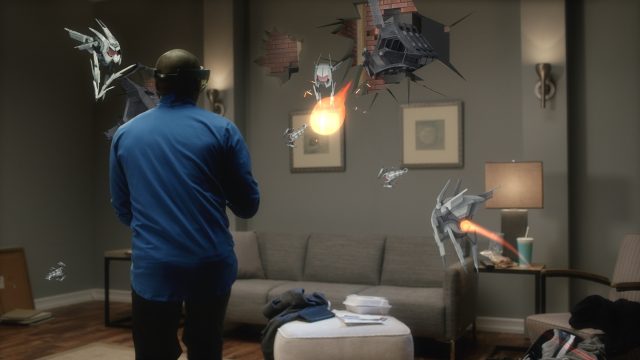
If you want to get your hands on Microsoft's holographic headset, the company is now taking pre-orders for the HoloLens Development Edition. Hardware will be shipping to the US and Canada on March 30, just scraping in to Microsoft's first-quarter deadline. As previously announced, the hardware will cost $3,000.
As pictured, the development kit appears to be relatively barebones, containing the HoloLens, a charger, the Bluetooth 4.1 Clicker that leaked earlier this week, a carrying case, a microfiber cloth, and replacement nose pieces. While the HoloLens itself is fully self-contained, running wirelessly and independently, developing HoloLens software will require a PC that can run Windows 10 and Visual Studio 2015.
Microsoft is being a little more forthcoming with some of the HoloLens hardware specs, though there are some oddities in there. We learned last year that the system was x86 powered with 2GB RAM, 802.11ac, and a 60Hz refresh rate. That hasn't changed, but now we have some more detail, particularly around its sensors. The headset is chock full of cameras—four to "understand" the environment, one to build depth maps of the world, and a 2MP camera for photography and video capture. It also incorporates four microphones, an ambient light sensor, and an inertial measurement unit that combines accelerometers and gyroscopes to detect movement.
This sensor data is processed by a custom "Holographic Processing Unit." The processor is an unspecified Intel part, which, oddly, appears to only be a 32-bit chip.
The company continues to be vague about its display capabilities and technology. HoloLens is described as having two 16:9 "light engines" (one per eye) that can produce a total of 2.3 million "light points," and it is optimized for a density of more than 2,500 light points per radian.
Connectivity is provided by 802.11ac, Bluetooth 4.1, and USB 2 connections. It has 64GB of onboard storage. Battery life is estimated at 2 to 3 hours of "active use," though it can be used while charging via its USB port. The whole thing weighs 579g/1.37lb.
The dev kit will also come with a range of apps, some of which we've seen before, others we haven't. Apps we've seen before will include HoloStudio, a 3D modeling app that was one of the very first apps Microsoft demonstrated for HoloLens, and Skype, which was also part of that initial reveal. A third app, HoloTour, strives to provide immersive 3D virtual trips to various landmarks around the world.

While Microsoft is initially emphasizing commercial and enterprise applications with HoloLens, the company is well aware of the gaming applications of the tech, and it's providing three games as such. One of these, RoboRaid was shown off last year at the Surface Book launch event (at the time it was codenamed Project X-Ray). In this game, robot invaders blast holes in the walls of the room you're in, and you have to shoot them as they fly around. Fragments is an as-yet-unseen "mixed-reality crime drama" that will see virtual characters join you in your own home as you investigate a crime. The third, also unseen, is Young Conker, a mixed-reality platform game that uses your environment to construct levels.
A little later in the year, these apps will be joined by Actiongram, which was a major part of the leak earlier this week. This is an app for creating mixed-reality videos that blend live action with holographic animation.
reader comments
39